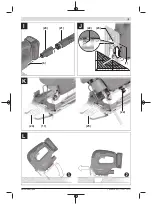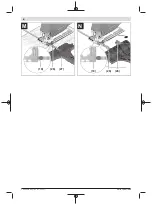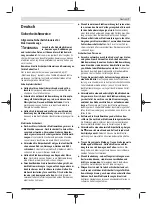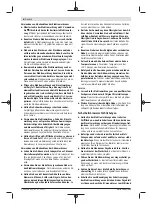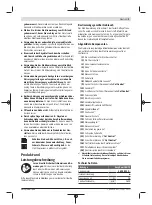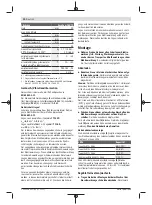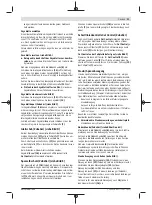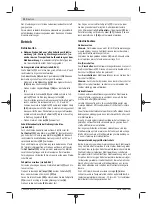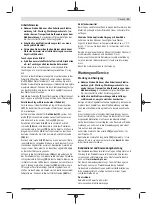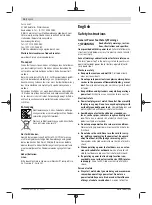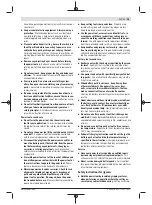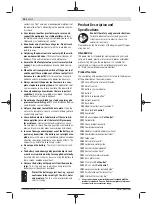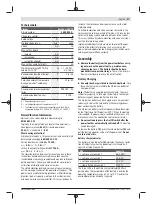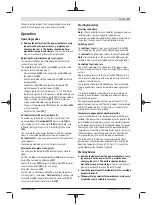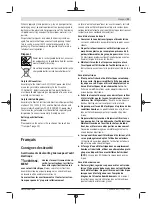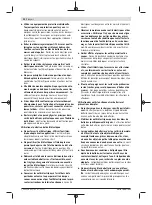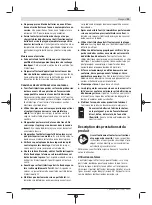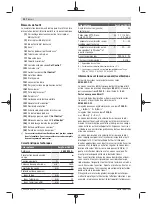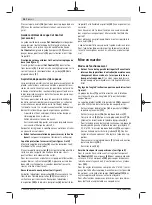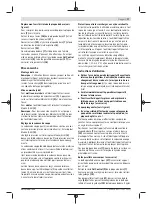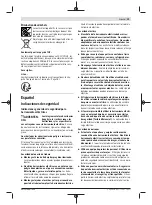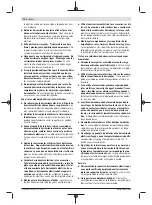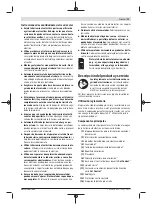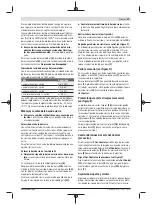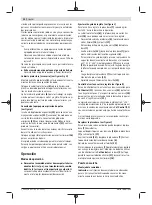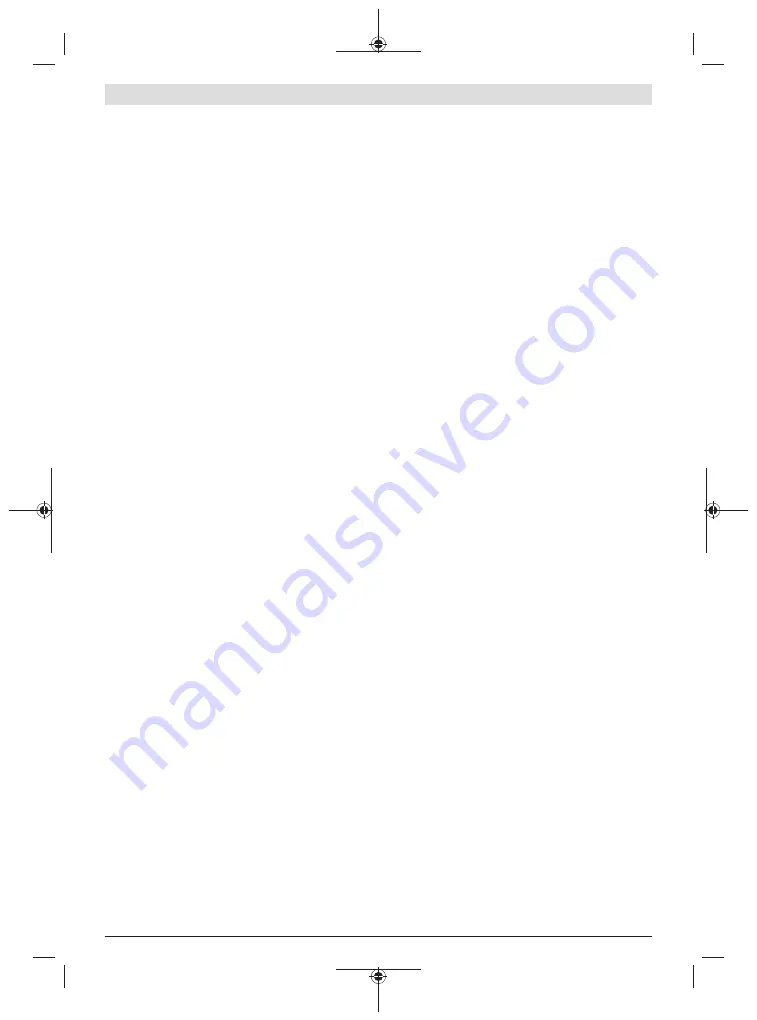
English |
19
When extracting dry dust that is especially detrimental to
health or carcinogenic, use a special dust extractor.
Operation
Operating modes
u
Remove the battery from the power tool before carry-
ing out work on the power tool (e.g. maintenance,
changing tool, etc.). The battery should also be re-
moved for transport and storage.
There is risk of injury
from unintentionally pressing the on/off switch.
Adjusting the mitre/bevel angle (see figure J)
The base plate
(7)
can be swivelled to the right or left to
make mitre cuts up to 45°.
The hood
(8)
and anti-splinter guard
(18)
cannot be used
while mitre cuts are being made.
– Remove the hood
(8)
, the anti-splinter guard
(18)
and
the glide shoe
(17)
.
– Pull the saw blade storage compartment
(16)
out of the
base plate
(7)
.
– Loosen the screw
(23)
and push the base plate
(7)
slightly towards the extraction outlet
(6)
.
– The base plate has lock-in points at 0°, 22.5° and 45° on
the left and right so that the precise mitre/bevel angle can
be adjusted. Swivel the base plate
(7)
to the required po-
sition according to the scale
(22)
. Other mitre/bevel
angles can be adjusted using a protractor.
– Then push the base plate
(7)
towards the saw blade
(10)
as far as it will go.
– Retighten the screw
(23)
.
Cut Control for mitre cuts (see figure K)
To enable you to track the cutting line (Cut Control), the
viewing window for
Cut Control
(11)
has a mark
(24)
for
right-angled cuts at 0° and a mark
(25)
for rightward- and
leftward-slanting mitre cuts at 45° according to the scale
(22)
.
The cut mark for mitre angles between 0° and 45° is propor-
tional. It can also be marked on the viewing window for
Cut Control
(11)
using a non-permanent marker and easily
removed again.
We recommend making a test cut for precise results.
Moving the base plate (see figure J)
You can move the base plate
(7)
back for sawing close to
edges.
Pull the saw blade storage compartment
(16)
out of the base
plate
(7)
or remove the glide shoe
(17)
.
Loosen the screw
(23)
and push the base plate
(7)
towards
the extraction outlet
(6)
as far as it will go.
Retighten the screw
(23)
.
Sawing with an offset base plate
(7)
is only possible with a
mitre angle of 0°. In addition,
Cut Control
must not be used
with the base
(9)
, the parallel guide with circle cutter
(27)
(accessory) or the anti-splinter guard
(18)
.
Starting Operation
Inserting the battery
Note:
The use of batteries unsuitable for your power tool can
lead to malfunctions or damage to the power tool.
Insert the charged battery
(4)
into the battery receptacle un-
til you feel it engage and it is securely locked in place.
Switching on/off
To
switch on
the power tool, press the lock-off switch
(1)
first. Then press the on/off switch
(2)
and keep it pressed.
To
switch off
the power tool, release the on/off switch
(2)
.
Note:
For safety reasons, the on/off switch
(2)
cannot be
locked; it must remain pressed during the entire operation.
Controlling the stroke rate
You can variably adjust the stroke rate of the power tool
when it is on by pressing in the on/off switch
(2)
to varying
extents.
Applying light pressure to the on/off switch
(2)
results in a
low stroke rate. Applying increasing pressure to the switch
increases the stroke rate.
The required stroke rate is dependent on the material and
the work conditions and can be determined using practical
tests.
It is recommended that you reduce the stroke rate when
placing the saw blade on the workpiece and when sawing
plastic and aluminium.
During prolonged periods of use at a low stroke rate, the
power tool may heat up significantly. Remove the saw blade
and let the power tool run at the maximum stroke rate for
around three minutes to cool down.
Temperature-dependent overload protection
In normal conditions of use, the power tool cannot be over-
loaded. If the power tool is overloaded or not kept within the
permitted battery temperature range, the speed is reduced
or the power tool switches off. At reduced speed, the power
tool will run again at full speed once the permitted battery
temperature is reached or the load is reduced. If it automat-
ically shuts down, switch the power tool off, allow the bat-
tery to cool down, then switch the power tool back on.
The three LEDs in the battery charge indicator
(3)
flash
quickly when the temperature of the battery is outside the
operating temperature range of −20 to +50 °C and/or the
overload protection has been triggered.
Working Advice
u
Remove the battery from the power tool before carry-
ing out work on the power tool (e.g. maintenance,
changing tool, etc.). The battery should also be re-
moved for transport and storage.
There is risk of injury
from unintentionally pressing the on/off switch.
u
Switch the power tool off immediately if the saw blade
becomes blocked.
u
When machining small or thin workpieces, always use
a stable base or saw table (accessory).
Bosch Power Tools
1 609 92A 64Y | (12.07.2021)
Содержание 0603012000
Страница 3: ... 3 A B 1 2 3 5 4 6 7 8 9 10 11 12 13 14 15 14 10 12 14 10 Bosch Power Tools 1 609 92A 64Y 12 07 2021 ...
Страница 4: ...4 C D E F G H 7 16 16 17 7 7 18 9 11 19 7 13 8 8 1 609 92A 64Y 12 07 2021 Bosch Power Tools ...
Страница 5: ... 5 I J K L 11 6 20 7 23 21 25 22 22 24 Bosch Power Tools 1 609 92A 64Y 12 07 2021 ...
Страница 6: ...6 M N 26 28 19 26 19 27 1 609 92A 64Y 12 07 2021 Bosch Power Tools ...
Страница 244: ...244 1 609 92A 64Y 12 07 2021 Bosch Power Tools ...
Страница 248: ...IV 1 609 92A 64Y 12 07 2021 Bosch Power Tools ...

